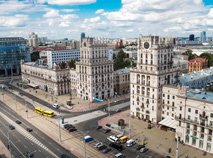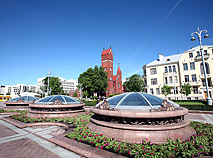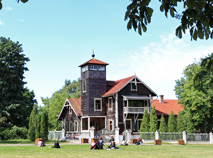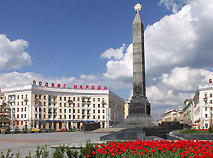Places to see in Minsk
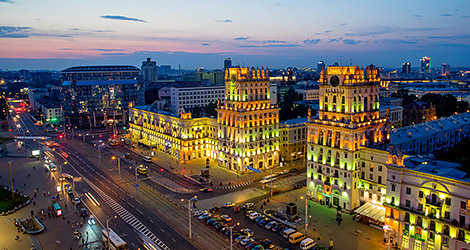
There is something for everyone to see and to do in Minsk. We offer you some tips on the city’s biggest attractions and the most exciting events.
One of the landmarks of the capital city is Independence Avenue that crosses Minsk from the center to the north-east. The avenue is 15km long, which makes it one of Europe’s longest city thoroughfares.

The avenue is famous for its architectural ensemble built in the Stalin’s Empire Style in the 1950s. The ensemble with its balustrades, outdoor lighting and flowers, seeks to get into the UNESCO World Heritage List.
The avenue passes through the city’s biggest squares:
-
Independence Square
-
October Square
-
Yakub Kolas Square

Independence Square is over 7 hectares big, which makes it one of the biggest squares in Europe. It was designed by Iosif Langbard for conducting rallies and military parades. The following facilities are located there today:
-
Government headquarters
-
Belarusian State University
-
Maxim Tank Belarusian State Pedagogical University
-
Minsk Metro headquarters
-
Minsk Mayor’s Office
-
Former commercial apartment buildings of the early 20th century, the Architect sculpture
-
Church of Saints Simon and Helen (Red Church)

The neo-Gothic Red Church was built in 1910 by order of aristocrat Edward Woyniłłowicz. The church was named and consecrated in memory of Woyniłłowicz's deceased children, Simon and Helen. His daughter Helen saw the future church in her sleep and drafted its sketch.
The "underground city", one of the biggest community and shopping centers Stolitsa, was built under Independence Square in the 21st century. The mall features numerous stores, cafes, restaurants and a parking space.
The following sights are located along Independence Square:
-
Tsentralny movie theater
-
Mastatstva art gallery
-
National Bank of Belarus
-
GUM shopping center
-
Palace of the Republic
-
National Academy of Sciences of Belarus
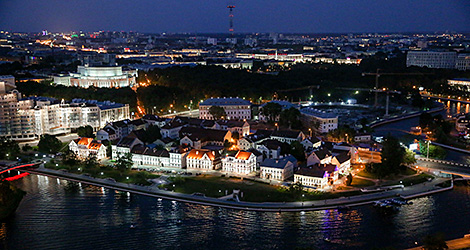
The historical center of Minsk has preserved majestic temples and historical landmarks. The pearl of Minsk downtown is the Trinity Suburb featuring the 19th century buildings and atmospheric block-paved side streets.
The second biggest thoroughfare of Minsk – Pobeditelei Avenue – starts at the ancient Upper Town near the Trinity Suburb.
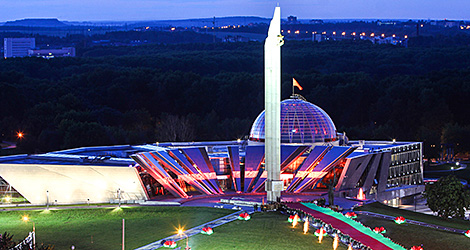
Along the avenue you can see:
-
Sports Palace and the stele called Olympic Time
-
Victory Park
-
Indoor Football Center
Parks and Gardens
Minsk is famous for its picturesque parks and gardens:
Gorky Central Children’s Park

The Gorky Park is situated near the Belarusian State Circus along the bank of the Svisloch River. During the warm season the park offers a number of rides and attractions, including the Observation Wheel that gives a wonderful view of the city.
Mikhailovsky Garden
It is a comfortable public garden near the Railway Station decorated with works by the famous Belarusian sculptor Vladimir Zhbanov that became landmarks of the city: Woman on a Bench, Girl under an Umbrella, and Man Lighting Up a Cigarette.
Aleksandrovsky Garden

This public garden is one of the most romantic places of the city situated near the Yanka Kupala National Academic Theater. The garden features the oldest fountain in Minsk that was installed in 1874 to celebrate the opening of the public water-supply system. The sculpture Boy with a Swan is placed at the center of the fountain. Its author Theodor Ernst Kalid got a medal at the Great Exhibition of the Works of Industry of All Nations held in London in 1851 and an order from the British Crown to make a copy of the sculpture. There are around 200 similar fountains in the world.
Troitskaya Gora Garden (Teatralny Garden)
The history of the public garden is connected with the ancient Troitskaya Square. After the reconstruction of the Bolshoi Theater of Belarus the garden was renovated too: now it has a dynamically lit fountain, the central walkway, and the opera and ballet walkways with the Opera and Ballet sculptures.
Central Botanical Garden of the National Academy of Sciences of Belarus

The Botanical Garden of the Belarusian National Academy of Sciences is one of the largest botanical gardens in Europe (around 100 hectares in the city). Its rich collection featurs over 10,000 plants from all over the world.
Chelyuskinites Park

The Chelyuskinites Park used to be called Komarovsky Les and was part of the Bolshaya Slepnya estate owned by the famous Radziwill and Vankovich families. Today there are around 22,000 trees in the park.
Victory Park

The park near Lake Komsomolskoye features the Isle of Birds wildlife reserve and beautiful illuminated fountains. People can take a walk along the shore of the lake, and those who prefer more active recreation can ride along the bikeway and swim in a usual or twin-hull boat.
Loshitsa Park

The old Loshitsa Estate in Minsk built in the 16th century belonged to such families as the Drutskys-Gorskys, the Tolochinskys, the Pruszynskis, and the Lyubanskys. In the second part of the 18th century, Adjutant-General Count Stanislaw Pruszynski remodeled the estate into a large residence that welcomed many outstanding people like the last King of the Polish-Lithuanian Commonwealth Stanislaw August Poniatowski, Russian Emperor Paul I, writer Vincent Dunin-Martsinkevich, composer Stanislaw Moniuszko…
The last owners of the Loshitsa Estate, Eustacjusz Lubanski and his wife Jadwiga, made it even more beautiful. The picturesque park featured exotic plants and the house was transformed into an elegant mansion where the family held theater and poetry evenings and celebrated folk holidays. European albums used to name the Loshitsa Estate among the most beautiful ones until Eustacjusz Lubanski left it in 1913 after Jadwiga’s tragic death.
Today the Loshitsa estate and park is one of the most beautiful places in Minsk where one can walk along the old alleys and visit the residence-museum. The original 19th-century interior decoration of the estate was restored in the result of a many-year reconstruction effort.
Museums of Minsk
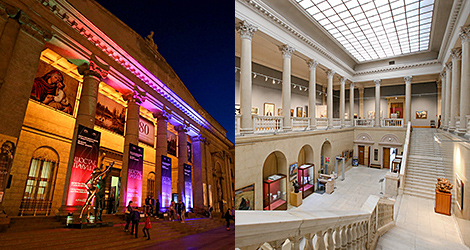
The biggest museums are located in the city’s downtown within walking distance:
-
National Museum of History and Culture of Belarus
-
Minsk’s History Museum
-
Museum of the Belarusian Cinema History
-
Yakub Kolas State Literature and Memorial Museum
The National Art Museum is the country’s main art treasury and one of the richest museums in Eastern Europe. The museum contains over 30,000 works of national and world art. In 2000 the Vankovich family estate in the Upper Town was made a subsidiary of the museum.

The National History Museum possesses the biggest collection in Belarus – about 377,000 exhibits: archeological finds, artwork and icons, manuscripts and books, musical instruments, coins and jewelry, weapons, clothes… Among the permanent exhibitions are Ancient Belarus, Ancient Heraldry of Belarus, History of Weapons, Ancient Urban Life (19th – early 20th centuries).
The National History Museum has two subsidiaries:
-
Museum of the 1st Congress of the Russian Social Democratic Labor Party
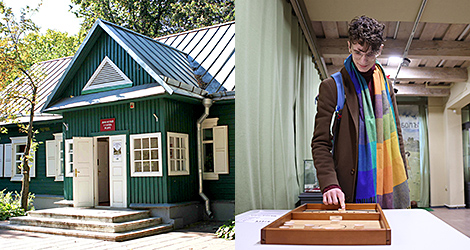
The Museum of the 1st Congress of the Russian Social Democratic Labor Party is one of the most renowned and oldest museums in Minsk. The museum recreates the atmosphere of the early 20th century. In different years the museum welcomed Fidel Castro, Maurice Thorez, Ho Chi Minh…
Other interesting museums in Minsk include:
-
Museum of Olympic Glory
-
Oceanography center Open Ocean
-
Museum of the Earth Science
The Museum of Olympic Glory displays over 23,000 exhibits: the national flag that flew on top of Everest, the Olympic cauldrons of 1980 and 2006, portraits, photos and awards of Belarusian Olympians: Alexander Medved’s silver order of the International Olympic Committee, awards of Olympic champions Vitaly Shcherbo, Victoria Azarenka, Darya Domracheva, Lyudmila Volchek ...
The Open Ocean Museum is inhabited by Petrovich the Giant Crab that predicted the outcome of the 2014 IIHF World Championship games.
Tours in Minsk

Tour operators have developed about 40 walking and bus tours in Minsk. Guides will tell tourists about the most interesting places in the Belarusian capital.
Minsk tour operators offer audio guides in foreign languages which tourists can use when walking round the city.
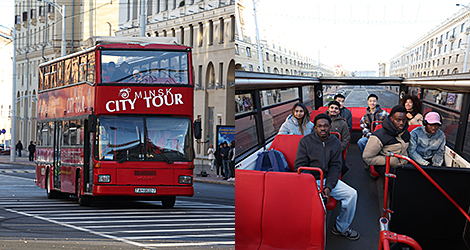
A double-decker Minsk City Tour is available every day: during the city tour you will visit the main sights in Minsk. The audio guide is available in Belarusian, Russian, English, German, French, Spanish, Italian and Chinese. The bus departs from Privokzalnaya Square at 11h00, 13h30, 16h00 and 18h30.
Prices:
-
Adults: Br30
-
Children: Br15 (no fee for under seven year olds)
Sightseeing bus No.1 can take you from the city center to Minsk Arena along the entire Pobeditelei Avenue. Information materials and audio guide are available in Russian and English. This kind of bus service is available from 10h00 to 17h00 and from 20h00 to 22h00 every day. During the rest of time this is city bus No.1 servicing the route Railway Station-Vesnyanka.
How to find your whereabouts in the city

You can buy a map or a Minsk guidebook in Belsoyuzpechyat outlets, souvenir shops and bookstores.
For example, the guidebook "Minsk is the Capital of Belarus," in Russian and English has been created specifically for the IIHF World Championship to help guests orient themselves.
You can also use an electronic guide which is an interactive map containing information about museums, hotels, restaurants, ATMs and fuel stations.
Many sights of the city are equipped with information boards, pointers and billboards with the map and a QR code which makes it possible to download information about the city sights to your phone. The map will help you view your whereabouts and get to the closest places of interest.
Metro stations are equipped with pointers in Russian and English. Toponyms are also transliterated.








 print version
print version make home page
make home page add to bookmarks
add to bookmarks
